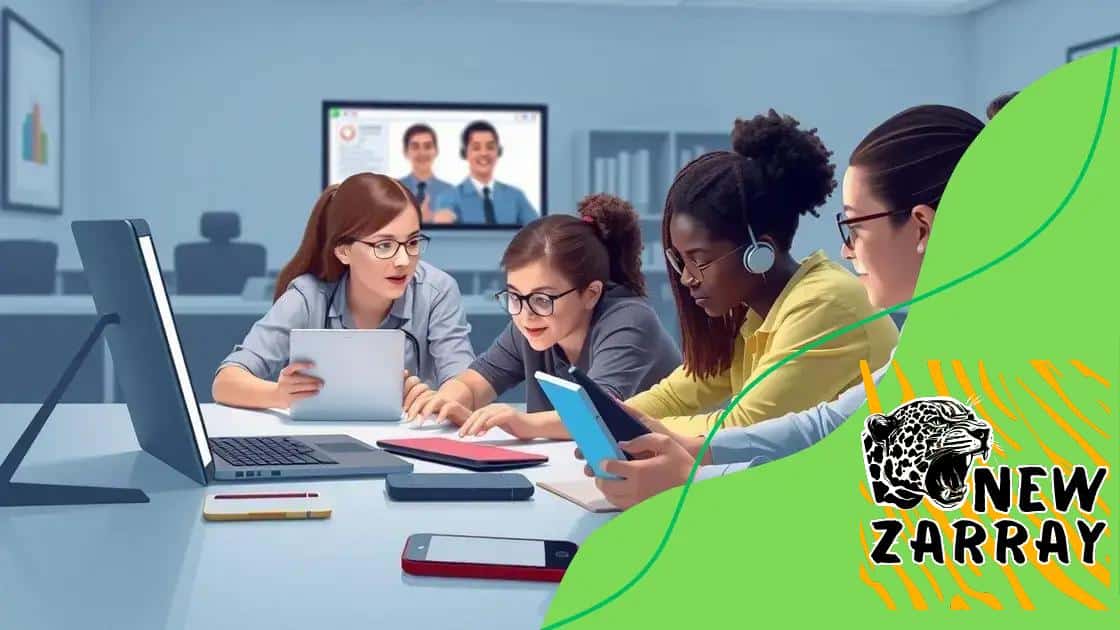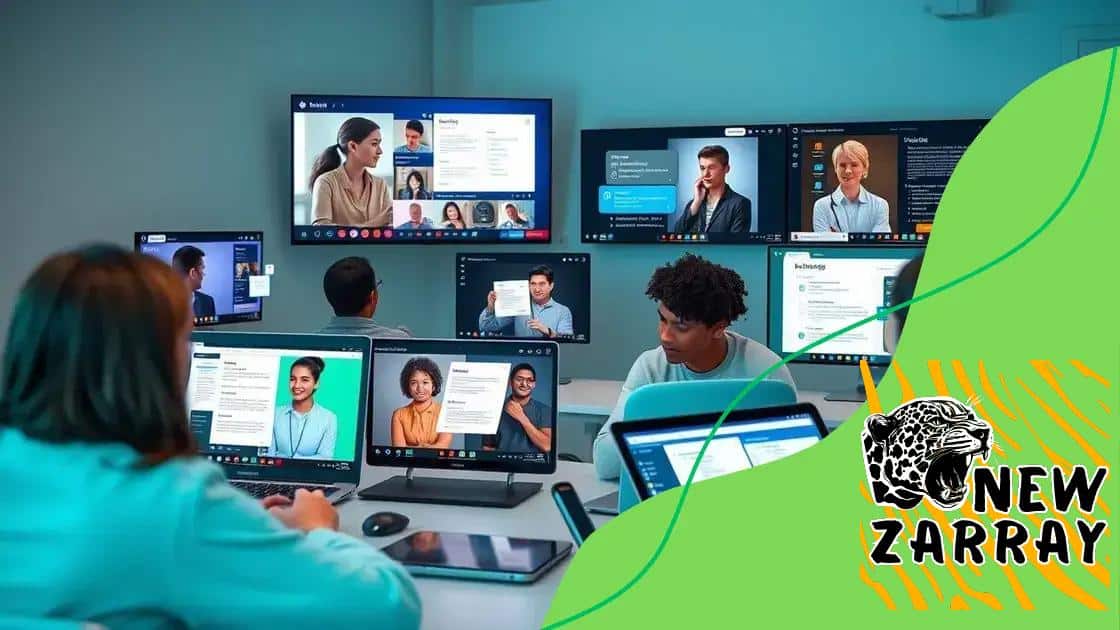The impact of virtual classrooms on student collaboration

The impact of virtual classrooms on student collaboration enhances engagement, promotes effective communication, and prepares students for a global workforce by using innovative tools and collaborative strategies.
The impact of virtual classrooms on student collaboration is becoming increasingly significant in today’s education landscape. Have you noticed how technology is changing the way students interact? This article explores the nuances and advantages of learning in a virtual environment.
Understanding virtual classrooms
Understanding virtual classrooms is essential in today’s digital learning environment. With the rise of technology, education has transformed into a more interactive and accessible format.
Virtual classrooms provide a space where students can engage actively with peers and instructors without being physically present. This setup not only offers flexibility but also enhances learning opportunities for everyone involved.
Advantages of virtual classrooms
There are several key benefits that come with using virtual classrooms:
- Accessibility: Students can join from anywhere with an internet connection.
- Flexibility: Classes can be recorded and accessed later for review.
- Engagement: Interactive tools keep students involved and motivated.
- Collaboration: Group discussions and projects can be conducted online seamlessly.
Moreover, virtual classrooms foster a sense of community among students. Through forums and chat rooms, learners can ask questions and share insights, making the educational experience more collaborative.
As we explore this further, it becomes clear that the tools available in virtual classrooms enhance communication. Features like video conferencing, messaging, and shared documents allow for real-time interaction, creating an engaging learning atmosphere.
Challenges to consider
However, it’s important to recognize some challenges associated with virtual classrooms. Some students may struggle with technology or face distractions at home. Creating a conducive learning environment is crucial for success.
Additionally, not all students may feel comfortable participating in online discussions, which can limit their engagement. Teachers play a key role in encouraging participation and providing support.
Overall, understanding virtual classrooms involves recognizing both the advantages and challenges they bring to the educational landscape. With the right tools and approaches, these classrooms can become a powerful way to enhance learning experiences for all students.
Benefits of virtual collaboration
The benefits of virtual collaboration are significant, especially in educational settings. Not only does it bring students together, but it also fosters a sense of community and teamwork.
With virtual collaboration, learners can connect from different locations, sharing ideas and resources in real-time. This opens up new opportunities for engagement that traditional classrooms might not provide.
Enhanced Communication
Effective communication is crucial in any learning environment. In virtual settings, students utilize a variety of tools that boost interaction:
- Video Conferencing: This allows for face-to-face discussions, enhancing understanding.
- Instant Messaging: Quick communication helps answer questions and share information promptly.
- Collaborative Platforms: Tools like Google Docs let students work together on projects seamlessly.
- Discussion Boards: These platforms encourage students to express their thoughts and engage in deeper discussions.
Moreover, the use of technology in virtual collaboration helps students develop skills they need in the modern workforce. They become more familiar with digital tools and learn how to communicate effectively online.
Flexibility and Convenience
Another key benefit of virtual collaboration is the flexibility it offers. Students can work together on projects anytime and anywhere, accommodating different schedules and learning styles. This can lead to more productive collaboration, as members can participate when they feel most focused. Plus, the convenience of accessing materials online reduces barriers to learning.
Through virtual collaboration, students also learn to manage their time effectively. They must coordinate their schedules and contribute to group tasks, fostering responsibility and independence.
Overall, the benefits of virtual collaboration extend beyond just learning. They prepare students for the collaborative nature of modern workplaces, making them better team players and effective communicators.
Tools for effective student interaction

Using the right tools for effective student interaction is essential in virtual classrooms. These tools enhance communication and engagement among students, creating a more interactive learning experience.
There are many options available that cater to different needs. Selecting the right tools can make a significant difference in how students collaborate and learn together.
Popular Interaction Tools
Some of the most popular tools used for effective student interaction include:
- Zoom: A widely used platform for video conferencing, allowing real-time discussions.
- Google Classroom: Facilitates assignments, discussions, and feedback all in one place.
- Slack: A messaging app that promotes communication and team collaboration.
- Trello: A project management tool that helps students organize tasks and work collaboratively.
Each of these tools offers unique features that encourage participation. For instance, Zoom allows for breakout rooms where students can engage in smaller groups. This setup helps facilitate deeper discussions and connections among peers.
Enhancing Engagement
Moreover, using collaboration tools not only fosters teamwork but also increases overall engagement. Interactive platforms offer quizzes and polls that can keep students involved and motivated.
Students can also create multimedia presentations using tools like Canva or Prezi, which enhance creativity in group projects. The ability to share screens and work together on documents or presentations in real-time helps build an inclusive learning environment.
Effective interaction in virtual classrooms is made possible by combining different tools and features. The right technology not only supports learning but also prepares students for future collaborative endeavors.
Challenges in virtual classroom settings
Challenges in virtual classroom settings can impact the learning experience. While these classrooms offer great flexibility, they also come with specific hurdles that educators and students must navigate.
One major issue is the difficulty that some learners face in adapting to technology. Not every student is comfortable using digital tools, which can hinder their participation in online classes.
Technical Issues
Technical problems can create significant barriers in virtual classrooms. Common challenges include:
- Internet Connectivity: Unstable or slow connections can disrupt learning.
- Device Compatibility: Some students may not have access to suitable devices.
- Software Glitches: Problems with software can interrupt lessons and frustrate students.
These technical issues can make it hard for students to engage fully. If a student struggles to connect or participates intermittently, their learning experience suffers.
Social Interaction Limitations
Another challenge is the lack of face-to-face interaction. In virtual classrooms, students may feel isolated compared to traditional settings. This can lead to feelings of disconnection from peers and educators.
Additionally, some students may hesitate to speak up or contribute during discussions due to a lack of confidence. Online environments can sometimes make it difficult for students to express themselves freely, affecting their engagement.
Creating a supportive atmosphere is vital. Teachers must actively encourage participation and find ways to foster social connections among students. This helps combat feelings of isolation and promotes a sense of community.
In conclusion, while virtual classrooms offer numerous benefits, certain challenges need to be addressed to enhance student learning effectively. By tackling technical issues and fostering interaction, educators can improve the online learning experience.
Future of education with virtual collaboration
The future of education with virtual collaboration holds great promise. As technology advances, learning environments are evolving. These changes are not just about having classes online; they reshape how students interact and learn together.
As we look ahead, we see that virtual collaboration can create more personalized learning experiences. Students can learn at their pace and engage with content that interests them. Teachers can tailor lessons to fit individual needs, allowing for a more effective educational experience.
Innovative Learning Approaches
New tools are emerging that facilitate collaboration among students. Some exciting trends include:
- Gamification: Incorporating game mechanics into education makes learning fun and engaging.
- Virtual Reality: Immersive experiences allow students to explore different environments and historical events firsthand.
- Online Communities: Platforms where students can share knowledge and resources foster peer support.
- Collaborative Project-Based Learning: Students work together on projects that connect real-world issues with their studies.
These innovative approaches encourage active participation and help develop essential skills like teamwork and problem-solving.
Global Learning Opportunities
The future of education is also about breaking down geographical barriers. Students from different parts of the world can collaborate on projects. This diversity fosters a richer learning experience where students learn from each other’s perspectives.
Moreover, virtual collaboration prepares students for a global workforce. They learn to communicate effectively with peers from various backgrounds, a valuable skill in today’s interconnected world. Schools that adopt virtual collaboration are equipping students with the tools they need for success.
In exploring the future of education, it’s clear that virtual collaboration is a key element. As technological advancements continue, the educational landscape will be more dynamic and interactive, making learning a truly engaging experience.
FAQ – Frequently Asked Questions about Virtual Classrooms and Collaboration
What are the primary benefits of virtual collaboration in education?
Virtual collaboration offers increased accessibility, enhanced communication among students, and the ability to work together on projects from different locations.
How can teachers facilitate better interactions in virtual classrooms?
Teachers can use interactive tools, encourage participation through discussions, and implement group activities to foster engagement.
What challenges do students face in virtual classrooms?
Students may struggle with technology issues, feel isolated due to lack of face-to-face interaction, or find it hard to communicate freely.
What tools can support effective virtual collaboration?
Tools like Zoom, Google Classroom, and Slack help in promoting effective communication and collaboration among students.





